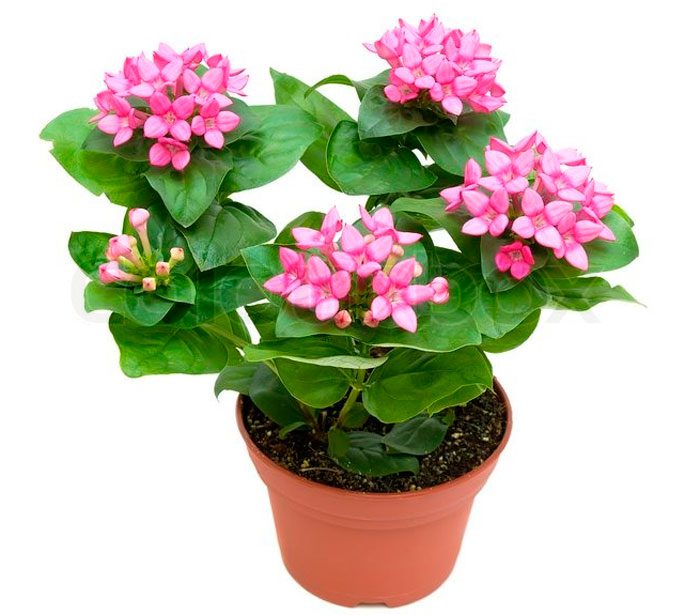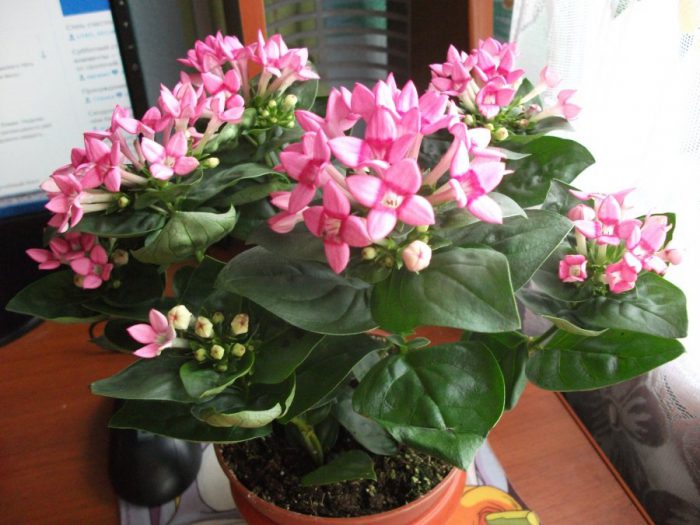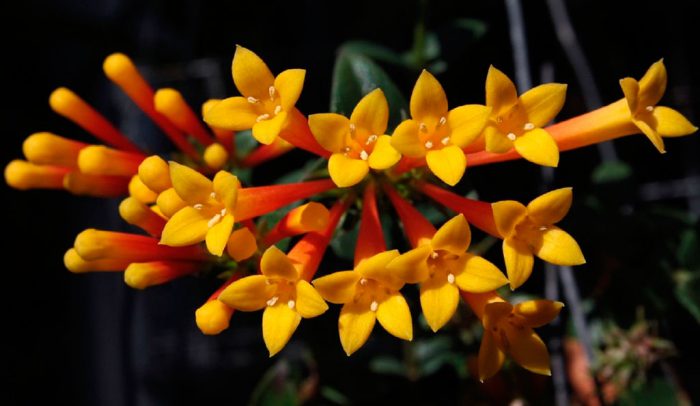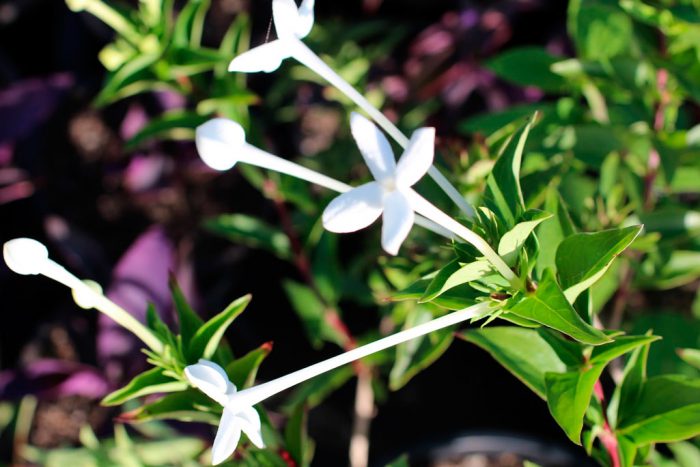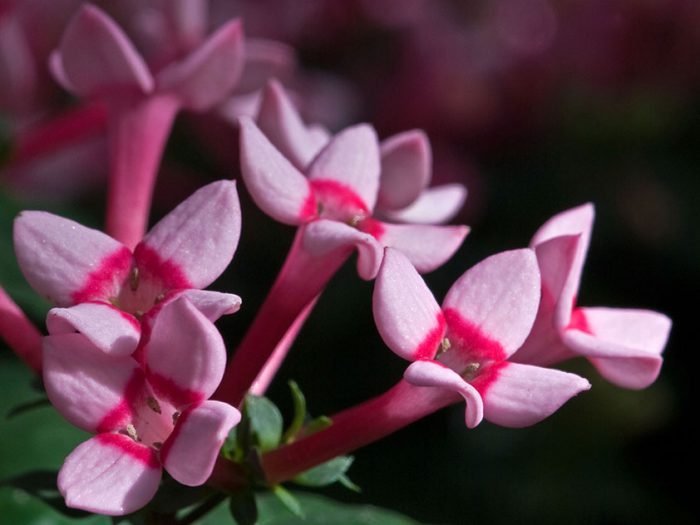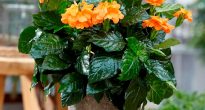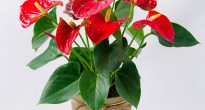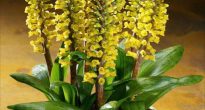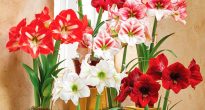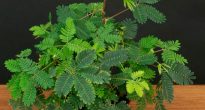Genus bouvardia is directly related to the madder family. It is represented by not very tall evergreen flowering herbaceous plants, as well as shrubs. In nature, they can be found in the subtropical and tropical regions of Central America and Mexico.
Plants of different types can have different heights from 50 to 150 centimeters. Erect weakly branched shoots have sparse internodes. They have short petiolate whorled or opposite leaves. Simple leaves reach 3-11 centimeters in length, from broad-lanceolate to lanceolate. They can also be ovoid with a pointed tip. The leaf blade is slightly leathery and smooth.
Long flowering. It lasts from the beginning of the summer to the end of the autumn period, it happens that it blooms in the winter. Multiflorous large fragrant inflorescences similar to a bouquet. They grow at the ends of annual stems and in some species their diameter is 15 centimeters. Tubular flowers have 4 lobes, which are bent back.
Bouvardia at home
Over the years, the popularity of this plant decreases. However, it is not capricious enough and caring for it is not so difficult.
Illumination
Needs good and diffused lighting. For the bouvardia to develop and grow normally, it needs lighting from 3000 to 3900 lux.
Temperature regime
In summer, moderate temperatures of 20 to 25 degrees are recommended. In winter, the plant needs rest, but only if it does not bloom in winter. During the dormant period, it is placed in a cool place of 10-12 degrees, it is impossible to get colder, as this may freeze the leaves.
How to water
During intensive growth, the plant is provided with regular moderate watering. It is recommended to water only after the top layer of the substrate dries out to a depth of 2 or 3 centimeters. Make sure that there is no stagnation of liquid in the soil, as this can provoke the appearance of rot on the shoots and the root system.
With the onset of winter, watering should be reduced, but at the same time, it is not necessary to allow the leaves and stems to be lethargic.
Water the plant with settled and soft water at room temperature, in which there is no chlorine.
Humidity
High humidity is not needed.However, for hygienic purposes, it is recommended to regularly arrange a warm shower for the plant, which will help remove accumulated dust and dirt from the foliage.
Pruning
In order for the bush to be more lush and bloom more abundantly, it is necessary to carry out a systematic pinching in the 1st year of life. And in autumn or spring, before the period of intensive growth begins, you need to cut off all the shoots by ½ part.
Earth mix
A suitable soil must be nutrient-dense and have good water and air permeability. For planting, a commercially available universal soil for indoor plants is also suitable, but it is recommended to add a small amount of vermiculite or perlite to it. The soil mixture can be made by hand, for this you need to mix peat, sod and leafy soil, as well as sand in a ratio of 2: 4: 1: 1.
Fertilizer
Top dressing is carried out during the period of intensive growth 2 times a month. To do this, use a complex mineral fertilizer or universal fertilizer for indoor plants. In winter, it is forbidden to apply fertilizer to the soil.
Transplant features
The disadvantage of such a plant is that it has abundant flowering only in the 2nd year of life. Moreover, in all the following years it will not be so abundant, or the bouvardia will not bloom at all. In this regard, experienced flower growers advise replacing this plant once every 2 years with a young one. The transplant is carried out only for young bushes that are one year old. This procedure should be carried out in springtime, and the flower should be placed in a larger pot.
Reproduction methods
It is very easy and simple to propagate bouvardia using cuttings. Apical stems are used for grafting. A cut cut should have 2 or 3 internodes. Rooting is quick and easy, and even a simple glass filled with clean water can be used.
By dividing the overgrown bush, you will also propagate the bouvardia. But in this case, the plant will not be renewed and therefore the flowering problem will not be solved.
Diseases and pests
Most often, such a plant gets sick with root rot. Its appearance, as a rule, is facilitated by the stagnation of liquid in the substrate with too much watering. While you are planting the plant, it is necessary to make a sufficiently high and good drainage layer in the container for preventive purposes. They simply get rid of a bush affected by root rot, because it cannot be cured, while it is recommended to cut it in order to get young plants.
Also, quite often such a plant suffers from leaf chlorosis. The cause of this disease is inappropriate water used for irrigation. To fight this disease, as well as for preventive purposes, it is necessary to feed with iron chelates.
The flower is resistant to pests, but aphids can settle on it. To get rid of it, the foliage should be thoroughly rinsed by arranging a warm shower in bouvardia.
Main types
Several species are grown indoors.
Bouvardia yellow (Bouvardia flava)
This species is tall and can reach 1 meter in height. It has lanceolate leaves and yellow flowers.
Bouvardia longiflora (Bouvardia longiflora)
It is also a rather tall flower, but its leaves are ovoid-pointed, and the snow-white flowers are incredibly fragrant.
Bouvardia jasminiflora (Bouvardia jasminiflora)
It is a dwarf plant that can grow up to 0.6 meters in height. It has snow-white fragrant flowers that resemble jasmine in appearance and smell. Blooms in winter.
Bouvardia domestica (Bouvardia domestica)
This is the most popular type. It can reach a height of 70 centimeters. It has ovoid-pointed leaves, painted in dark green. In length, they reach 5 centimeters. The flowers have a different color depending on the variety - from rich to light pink or crimson. There are terry forms.

